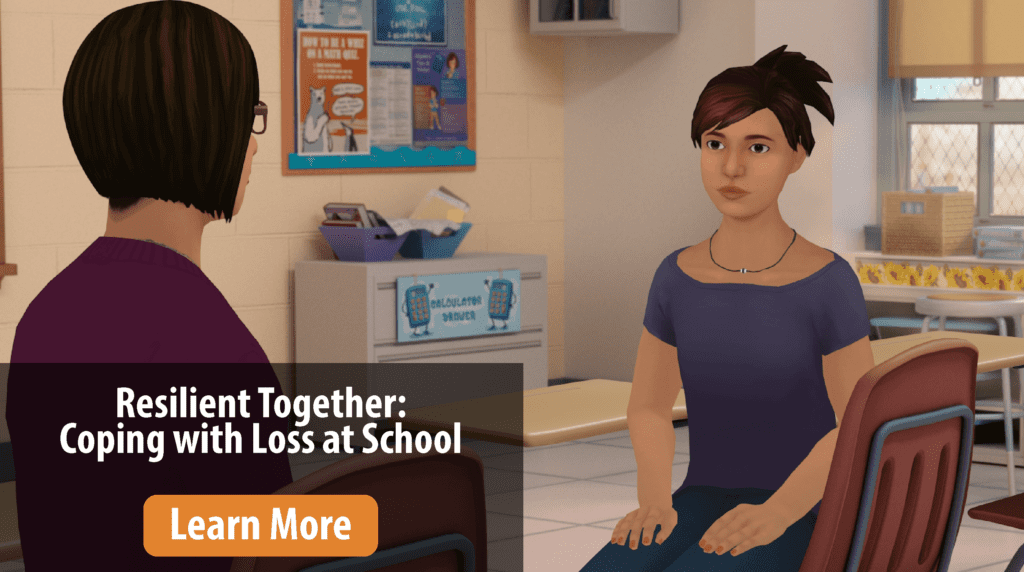Helping Students Deal with Grief in the Classroom: Are Schools Ready?
Students are returning to school with a range of experiences, and the transition back to the classroom could be difficult. As educators prepare for the school year, it’s important to remember that some students may be grieving the loss of a family member, friend, or even peer.
In addition to a crisis response plan, teachers and administrators need to prepare to have difficult conversations when helping students deal with grief in the classroom, and build resiliency among students and staff. Are they ready to have these conversations?
Helping Students Deal with Grief in the Classroom: Are Educators Prepared?
We surveyed nearly 12,000 PK-12 educators across seven states to determine how prepared they were to respond to grief and loss in the school community.
The survey was conducted between March 2020 and March 2021. Participants were asked to complete a brief online survey as the first step in taking Kognito’s simulation, Resilient Together: Coping with Loss at School. Participants were not required to complete the surveys and were not compensated for their participation.
You can access the full results at kognito.com, or keep reading for a brief summary of the findings.
Schools are coping with the loss of students.
Of the educators surveyed, 41% have experienced the death of a student. On average, these educators talked with two students and one colleague who showed signs of distress.
Many educators are not adequately prepared to respond to a death in the school community.
While a large number of educators report feeling confident to respond to students and colleagues about a loss, many report not feeling adequately prepared for this response. This gap speaks to the need for additional training to ready educators to handle moments of crisis and grief.
Educators need more confidence talking to students about the death of a classmate.
Over half (51%) of respondents said they were not prepared to help a student open up to talk about their feelings of loss. 46% were not prepared to motivate a student to connect with support services.
Staff need to know how to recognize warning signs that a student may need help.
Grief reactions differ according to age and developmental level, and helping students deal with grief in the classroom starts with being able to recognize when a student is struggling. Nearly half (47%) of educators surveyed do not feel prepared to recognize when a student is showing signs of psychological distress.
It’s not only about the students. Staff need to prioritize self-care and watch out for each other, too.
When there’s a death in the school community, everyone is affected. Self-care is essential in the mourning process, and adults may also need support as they cope with loss. When asked if they feel prepared to engage in self-care, 45% of educators said no. Another 47% do not feel prepared to motivate a colleague to connect with support services.
Professional Development Can Help Schools Prepare to Respond to Grief and Loss
Fewer than half of teachers have access to a school protocol for helping students deal with grief in the classroom, and 93% have not received bereavement training, according to a survey by the American Federation of Teachers.
So what can we do? Dr. Scott Poland says that “it’s about prevention and better planning.” Dr. Poland is a licensed psychologist and an internationally recognized expert on school safety, youth suicide, self-injury, bullying, school crisis prevention/intervention, threat assessment, and parenting in challenging times.
“Unfortunately, every school has had to deal with the death of a staff member or a student. Traveling around the country and presenting, all schools have what I would call a skeleton in the closet. Something sad happened. I don’t want to make them feel bad, but the part that’s missing is to sit around the table and say, ‘What do we do? What worked? What didn’t work? What’d we learn?’ When we tragically have to deal with another school death, how could we respond better, and then very importantly, is there anything we can do to prevent the tragic deaths of kids?”
About Resilient Together
Dr. Poland is a national suicide prevention leader, and one of the subject matter experts who helped in the design of Kognito’s professional development role-play experience that prepares K-12 school personnel to respond to a death in the school community.
The 40-minute simulation, Resilient Together: Coping with Loss at School, helps teachers and administrators:
- implement an effective crisis response plan,
- understand the unique circumstances surrounding a death by suicide,
- and effectively communicate with students and colleagues who are exhibiting signs of distress.
Crisis and loss can cause short- and long-term effects on students’ mental, emotional, and physical health, academic performance, and developmental trajectory. Schools have an opportunity to help students by establishing a crisis response plan—including extra considerations for postvention when dealing with a death by suicide—as well as training educators to spot signs of distress, affirm and normalize their emotions, and connect them with support. These efforts can assist schools in creating a supportive community to help students when they need it most.
Download the Whitepaper
To access the full results of our survey of nearly 12,000 PK-12 educators, download the free whitepaper at Kognito.com.
